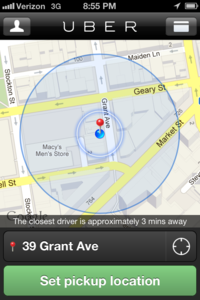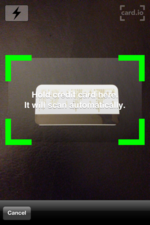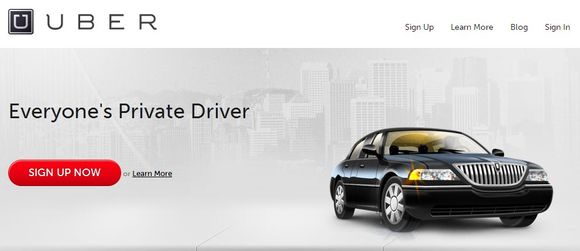 Several weeks ago I was standing on a street corner in New York. (This is not the sentence I thought I'd start this post with, but go with me …) After unsuccessfully trying to hail a cab, I decided to try out an app I had heard about called Uber. I had heard it was useful for those kinds of situations. From the moment of signup – a process which took way less time than I expected, to the actual act of immediately booking a car and heading happily on my way to LaGuardia Airport just 15 minutes later – the experience transformed my NY trip. Experience itself is getting lots of great media attention for solving a big problem in the taxicab experience – but what was particularly interesting for me, of course, was the marketing lessons their successful experience can offer. Here are five big lessons you can learn from Uber:
Several weeks ago I was standing on a street corner in New York. (This is not the sentence I thought I'd start this post with, but go with me …) After unsuccessfully trying to hail a cab, I decided to try out an app I had heard about called Uber. I had heard it was useful for those kinds of situations. From the moment of signup – a process which took way less time than I expected, to the actual act of immediately booking a car and heading happily on my way to LaGuardia Airport just 15 minutes later – the experience transformed my NY trip. Experience itself is getting lots of great media attention for solving a big problem in the taxicab experience – but what was particularly interesting for me, of course, was the marketing lessons their successful experience can offer. Here are five big lessons you can learn from Uber:
- Simplify mobile signups. I hardly ever sign up for any kind of service on my phone, because typing on a touch screen is such a pain. Unfortunately, when signing up for Uber, I was literally standing on a street corner and had no choice. The app seemed to be designed for exactly that. They only captured the most important and basic details, and let me take a photo of my credit card to scan in the number (instead of having to type it). Every app and signup process should do this one simple thing.
 Add fun to necessary waiting. After I requested a pickup, the app confirmed that I had a driver … but it didn't stop there. As I was waiting, the app showed a Google map image of where I was and where my car was. Then I could track my car's progress in real time as it drove to meet me. Sure I was checking email and Twitter while waiting, but it was actually fun (yes fun!) to watch that car coming closer and closer until it arrived exactly as the map predicted. No empty hoping that every next car would be mine. The entire experience was stress free.
Add fun to necessary waiting. After I requested a pickup, the app confirmed that I had a driver … but it didn't stop there. As I was waiting, the app showed a Google map image of where I was and where my car was. Then I could track my car's progress in real time as it drove to meet me. Sure I was checking email and Twitter while waiting, but it was actually fun (yes fun!) to watch that car coming closer and closer until it arrived exactly as the map predicted. No empty hoping that every next car would be mine. The entire experience was stress free.- Give people useful data they didn't ask for. After my trip, I received an email with my final total cost for the trip and a receipt. This was what I expected. What I didn't expect was that they also told me exactly how long my journey had taken, how many miles we traveled (which is how they calculate the fare) and what the average speed was that whole time. I definitely didn't need that information, but somehow I was still glad to have it.
- Make rating a two way street. When your journey finishes, you have the chance to rate your driver – which is nice. What you don't expect is that your driver also has a chance to rate you. So now karma has a real rating system, and it penalizes you for being an a-hole to your driver, if you happen to be that kind of person. That's how the world should work, and people should get rewarded or penalized for how they treat other people, so I love this. Not to mention that it finally gives drivers some way to be part of that rating conversation as well.
- Don't apologize for excluding some people. The app has been criticized for its focus on urban city dwellers and price point that makes it about 50% more expensive than taxis, if not more. But this criticism also means that they have a clear picture of who their target audience is … a consumer who doesn't mind paying more for the reliability and comfort of a clean black sedan that shows up exactly when you expect it.
All of these together make Uber probably my favourite new app … and marketing story to offer lessons to each of us no matter what we are trying to promote.























Excellent post Rohit, Uber or not, these are 5 lessons anyone in the service, hospitality or travel industry should take to heart.
I especially like the opportunities presented via #4, the karma rating system, if you will. A great opportunity to hear the other side of that negative (consumer) review.
– Troy
Less may be more, as a lesson for ‘any’ successful app design!. Less equals more privacy; an app that users can trust – versus the dodge-ball usage game to protect ones information throughout the constant flow of voluntary output – which is sometimes linked to an insecure access point.
Question: How many cell phones wash up in the Hudson river? How many are misplaced daily?. Banking apps, GPS apps may all be logged-in. Users like simple, so protect them in order to dominate the niche and usage. They look for competitors when its too ‘wrapped in’ to their tech. Tech itself is getting better but still has plenty of siphoning holes. Give clients ideas that seal trust into the equation, users notice.
P.S. A useful and secure app – is an app that can request additional information, at a later time and usually get it. Give to receive!
BW
https://www.wilkinsbarbera.com
I just sent this post to a bunch of my friends as I agree with most of what you’re saying here and the way you’ve presented it is awesome.
You did us a favor by sharing your experience with this app. I have heard of Uber but have not had an opportunity to try out myself. Thanks to you I’d know what to do when I get myself in this kind of situation. Great insights, by the way.